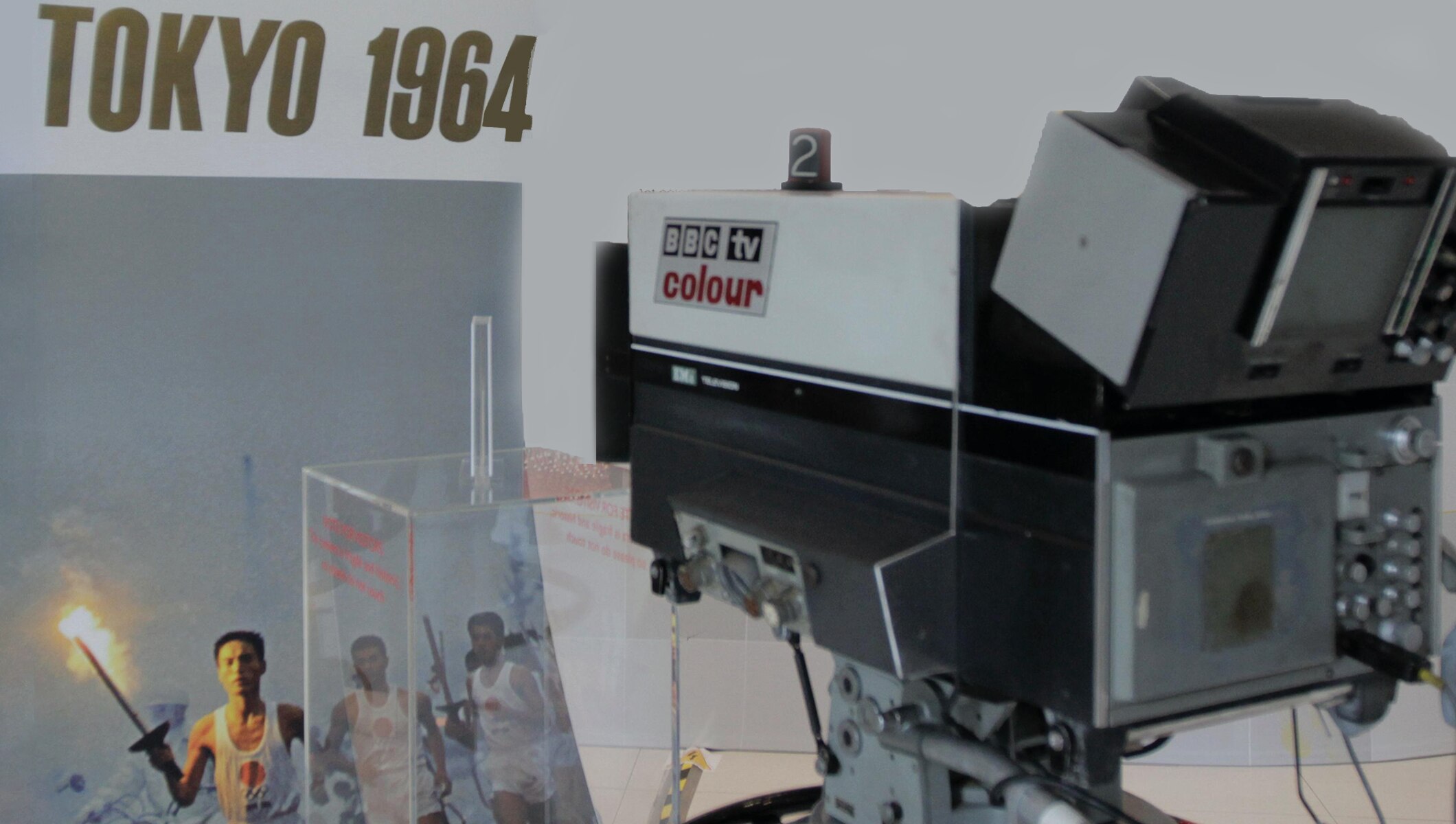Tokyo 1964
Worldwide TV broadcasting by satellite; a big leap for the pole vault with fibre glass poles; and swimming with timing touch pads fixed to the pool walls… But also the last athletics races at the Games on a cinder track – the Games in Tokyo served as a springboard to the future… to the next edition, in 2020!
Artificial satellites used to broadcast the Games
In 1957, the USSR conducted its first space mission by sending an artificial satellite – the famous “Sputnik” – into orbit around the Earth. Very quickly, the possibilities of using satellites for communication were studied. The first geosynchronous satellite used for this purpose was American, Syncom II, launched in July 1963. The organisers of the Tokyo 1964 Games had many ideas to make these the “Technology Games”. Upon seeing this satellite, the purpose of which was to provide telephone communications across the world, they contacted the US authorities in Washington and asked them if this orbiting satellite could be adapted to relay TV signals, so that, for the first time, the Games could be broadcast simultaneously on more than one continent.
“They got a warm reception,” said John Slater, a professor from Western Carolina University, in the North American Society for Sport History periodical, in 2000. “With the full support of both governments, other agencies fell into line. The Japanese Broadcasting Corporation built a transmitter site north of Tokyo, and the US Navy modified its communication facility at Pt. Mugu, CA, to receive the signals. NASA relocated Syncom II from the Atlantic to the Pacific to test the concept, and then launched and positioned a new satellite, Syncom III, in August 1964 to carry out the broadcast. The U.S. Department of State coordinated the use of the necessary radio frequencies. The system worked…” So, from the USA and Canada to Europe, via Asia, for the first time, Olympic fans could watch the events live on their TV screens. What seems normal in the 21st century, in the communication era, was a huge first 55 years ago!
#50 years ago #today, Syncom 3, the world’s 1st geostationary satellite launched http://t.co/BJ445qoOSi pic.twitter.com/7bT8GvFvs4
— NASA History Office (@NASAhistory) 19 August 2014
A big leap for the pole vault
Vaulting with a pole has been practised since time immemorial. There are signs of people using stiff wooden poles to cross waterways or various obstacles in ancient times. The activity became a competitive sport in the second half of the 19th century in Europe and the USA, with wooden or bamboo poles used at first (at that point they jumped with their feet together). Pierre de Coubertin included the discipline on the Olympic programme of the first Games of the modern era in Athens in 1896, and it developed from there. The “box” appeared, as did the landing mat, known as the “pit”. Later, in the 1940s, the poles were made of metal.
This was how the USA’s Don Bragg triumphed at the Games in Rome in 1960 with a jump of 4.70m. But shortly afterwards, thanks to space technology developed by NASA, fibre glass poles appeared. They were much more flexible and released more kinetic energy than the materials used to date. While Bragg’s metal pole could bend 45°, athletes now try to reach 90° to propel themselves in the air when the pole straightens out!
Then came Fred Hansen, Bragg’s fellow countryman, born in 1940 in Cueno, Texas. In the same year as the Tokyo Games, using this new pole, he won the US trials with a jump of 5.18m. In July, in Los Angeles, he set a world record of 5.28m. On 17 October 1964, in the Tokyo Olympic Stadium, Fred Hansen was the first Olympic champion to win with this material, passing on all his jumps up to 5m, before clearing 5.10m, on his third attempt, to win the gold medal.
The Games held in the Japanese capital therefore marked an important technological advance for a discipline whose current Olympic record is 6.03m (set by Brazil’s Thiago Braz Da Silva in Rio in 2016) and whose world record is 6.16m (set by France’s Renaud Lavillenie in Donetsk in February 2014).
In swimming, birth of the touch pads
As for swimming, after what had been considered a mistake at the Rome Games in 1960 – Australia’s John Devitt was declared the winner of the 100m ahead of the USA’s Lance Larson with an identical time, even to the tenth of a second (55.2), OMEGA, the Official Timekeeper of the Games, sought out solutions so that the manual timekeepers no longer had any influence on the results of the races.
So, for the first time at the Games, in Tokyo in 1964, the Olympic pool was modified to allow for impulse sensors to be fitted on the wall. This was a key Olympic first, but one that still had be fine-tuned. The principle, tested here on a large scale, was approved only in 1967. Touch pads were used at the Pan-American Games in Winnipeg and have been used ever since. Like for the pole vault, the Games of the XVIII Olympiad marked an important technological development for the swimming competitions.
The cinder track… for the last time
Finally, at odds with all these technological advances, but already with an eye to the future, the athletics races at Tokyo 1964 were the last to be staged on a cinder track. But what was this exactly? Imagine the clay still used on the tennis courts at the Roland Garros tournament: it was the same type of surface, made from flattened rubble. The lanes were first separated by ropes, then in the Olympic Stadium in Tokyo, by vinyl lines.
In his book The Greatest Year in the History of Japan, Olympic historian Roy Tomizawa quotes Ollan Cassell, a member of the US winning 4x400m relay team who set a world record of 3:07 minutes. “The cinders were always uneven and needed long spikes, which dug into the track and attracted the material into the shoes. This made it more difficult to glide and run like on a cloud.” The sound of the foot strikes on the cinder track was also very different from what we have today. Bob Hayes’ world record in the 100m in 10 seconds flat set in the final on the Tokyo “cinders” was the last to be set on this surface.
Later, synthetic athletics tracks became widespread, and their properties were very different. “The all-weather track made it necessary for shoe companies to make special shoes with much shorter spikes, often called brush spikes, to keep the damage to the track to a minimum. You could also get a better stride rhythm with less resistance, as well as receive more bounce form each stride,” said Cassell. In Mexico City in 1968, the track was made of Tartan, the timing was electronic, and the USA’s Jim Hines won in 9.95 seconds, a world record that would stand for 15 years.
On course for new “Technology Games”!
Tokyo is hosting the Games again in 2020 and, just like 56 years ago, the Organising Committee will make the most of the advances of the 21st century to again stage “Technology Games”: using 100 per cent renewable energy (solar and wind power for the Village and competition venues); recovering small quantities of gold, silver and bronze from mobile phones to make the 5,000 medals; recycling 99 per cent of the materials used during the Games; providing self-driving taxis for which phones are used to unlock the doors and pay for the journey; having a wide-scale presence of robots serving as interpreters and load carriers, and so forth.
1964 and 2020: two important years in the history and development of Japan!

















